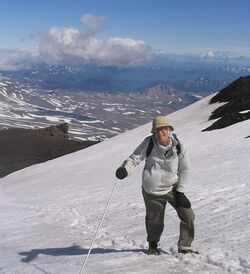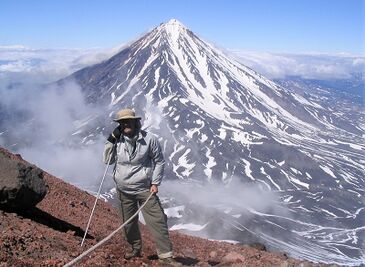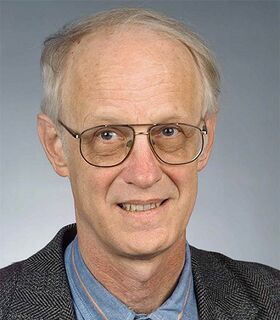Richard Van Evera Lovelace
Richard Van Evera Lovelace (1941.10.16, St. Louis, USA) is astrophysicist and plasma physicist. Lovelace is best known for the discovery of the period of pulsar in the Crab Nebula (Crab pulsar), which helped to prove that pulsars are rotating neutron stars, for developing a magnetic model of jets from galaxies, and for developing a model of Rossby waves in accretion disks. He organized the US-Russia collaboration in Plasma Astrophysics, which obtained many pioneering results in modeling of plasma accretion and outflows from magnetized rotating stars.
Early life
Lovelace was born in Saint Louis on October 16, 1941. His father, Eldridge Lovelace, was a city planner, and had frequent travels to cities in the US and abroad. He often took his family with him, and Richard visited many places in the US and other countries. Father was also a specialist in parks and an artist, so that they visited many parks, museums and art galleries. Richard's mother Marjorie Van Evera Lovelace, liked to write. She wrote a book about family trips and other stories: ``Marjorie Remembers.
Richard went to John Burroughs school, where he showed talent in physics and math. He collected in a home lab different electronic equipment, and developed radios, etc. He was interested in the space program. In 1957, he observed the Soviet Sputnik, passing over Saint Louis, and together with parents, he went to Florida to observe the first launches of American spacecrafts.
Education
Lovelace attended the Carnegie Tech and Washington University (St. Louis), and in 1964 he received a Bachelor degree from Washington University. He was a graduate student at Cornell University, and obtained PhD in Physics in 1970 working under Prof. E. E. Salpeter.
Discovery of the Crab Pulsar period
As a graduate student, Lovelace went to Arecibo observatory, where he developed a special fast-Fourier transform program.[1]. The special code named Gallop in Fortran was adapted to run on the Arecibo Observatory's CDC 3200 computer which had a memory of 32,000 words of 24 bit length. The code was integer based using half-words of 12 bits and was able to do the fast Fourier transform of N=16,384 signal samples. The 8192 signal power values were printed out on a folded raster scan. The signal to noise ratio increases as N increases. This was the largest value of N which could be handled by the Arecibo computer. This program helped to separate the periodic pulsar signal from the noise, and one night he discovered the period of the Crab pulsar, which is approximately 33 ms (33.09 ms) [2]. This was the fastest pulsar found at that time. After this discovery, scientists concluded that pulsars were rotating neutron stars[3]. Before that, many scientists believed that pulsars were pulsating white dwarfs.
Career
-- Lovelace is Professor at Cornell University from 1972. He is Professor in the Department of the Applied and Engineering Physics and the Astronomy Department.
-- Fellow of American Physical Society, 2002
-- Orsan Anderson Visiting Scholar at Los Alamos National Laboratory 1999-2000
-- Lifetime Fellow at [[Churchill College,_Cambridge] University and Visiting Scientist at the Institute of Astronomy, Cambridge England, 1994-1995
-- Guggenheim Fellow and Visiting Professor in the Department of Physics at the University of Texas at Austin, 1990-1991
-- Lovelace has been teaching different classes for undergraduate and graduate students. For the “Continuum Physics” class, he developed a suite of 14 demonstrations including a Venturi tube and a smoke-ring generator. See an example of experiment with fluids here inhomogeneities in rotating fluid here. With one of the students, Greg Stein, he has written a book ``Fluid Flows. He has taught for many years the graduate course on Applied Electrodynamics. Lovelace was Director of Master of Engineering Program 1991--2000. Awarded for Excellence in Teaching Prize from the Engineering Honor Society Tau Beta Pi, 1988.
-- Lovelace was a member of the Maxwell prize committee of the [https://en.wikipedia.org/wiki/American_Physical_Society American Physical Society] 2009-2011.
-- He was a member of the Advisory board of the Guggenheim Foundation, 1994-2005.
-- Divisional Associate Editor, Physical Review Letters, 1997-2000. Associate Editor of Physics of Plasmas, 2003-2019. Editorial board member: Journal of Computational Astrophysics and Cosmology, 2010 - present.
-- In 1991, he started the US-Russia Collaboration in Plasma Astrophysics. This collaboration helped to achieve many pioneering results in science. This is the only US-Russian collaboration in plasma astrophysics.
-- In 2000, he initiated the US-Kazakhstan Astrophysics Collaboration, which greatly helped scientists of Kazakhstan.
Research
1. In 1969, Lovelace discovered period \(P\!\approx 33\) ms of the Crab Nebula pulsar [2].
2. Proposed a model of jets from disks surrounding massive black holes in galaxies
[4]. The model is based on the dynamo mechanism acting in the magnetized accretion disk surrounding a black hole or other gravitating object. The model has been widely accepted by the astronomical community and now is the main model explaining jets from galaxies, stars and planets.
3. Proposed the Rossby waves instability in accretion disks[5]. These waves form anti-cyclonic vorticies in accretion discs, where dust particles accumulate and form planets [6].
4. Developed the theory of the stability of electron and ion rings (e.g., [7]). The theory is used in the current laboratory experiments on the magnetic confinement fusion (e.g., in the TAE Technologies in California).
Other Scientific Achievements
-- Proposed a new method of measuring magnetic fields [8].
-- Developed pioneering theory of intense ion beams in pulsed diodes, which are currently used in laboratories [9].
-- Proposed the theory of magnetic insulation. The theory is used in laboratories, for example in Sandia National Laboratory [10].
-- Invented trapping mechanism of spin-polarized neutral gas. The mechanism has been experimentally demonstrated. [11][12].
-- Developed theory and simulations of scintillations in the interstellar medium [13].
-- Discovered the Kolmogoroff nature of the turbulence in the Solar wind [14].
-- In collaboration with Russian mathematicians, developed a global, three-dimensional numerical model of the disk-accreting magnetized stars. Many pioneering results were obtained with this 3D MHD model (e.g., [15].)
-- Provided the first estimate of the electric current in the astrophysical jet\[ 3\times 10^{18}\] Amps. [16].
Travels to Siberia
Richard liked to travel in Siberia. He climbed Altay and Sayani mountains, visited Yakuiya and Lake Baikal, climbed Avachinsky and Mutnovsky volcanos of Kamchatka.



Richard at Kamchatka. First picture: Near Avachinsky volcano. Second and third pictures: Climbing
Avachinsky volcano. Third picture: Koryaksky volcano at background.
References
- ↑ ``Digital Search Methods for Pulsars 1969, R. V. E. Lovelace, J. M. Sutton, E. E. Salpeter Nature 222 (5190), 231-233
- ↑ Jump up to: 2.0 2.1 ``Crab nebula pulsar NP 0532 1969, J. M. Comella, H. D. Craft, R. V. E. Lovelace, J. M. Sutton, G. L. Tyler Nature 221 (5179), 453-454
- ↑ "On the discovery of the period of the Crab Nebula pulsar" 2012, R. V. E. Lovelace and G. L. Tyler, The Observatory 132, 186–187
- ↑ "Dynamo model of double radio sources" R. V. E. Lovelace 1976, Nature 262 (5570), 649-652.
- ↑ ``Rossby wave instability of Keplerian accretion disks R. V. E. Lovelace, H. Li, S. A. Colgate, A. F. Nelson 1999, The Astrophysical Journal 513 (2), 805.
- ↑ ``Rossby wave instability in astrophysical discs R. V. E. Lovelace & M. M. Romanova, Fluid Dynamics Research, v. 46, p. 041401.
- ↑ ``Low-frequency stability of astron configurations R. V. E. Lovelace 1975, Physical Review Letters 35 (3), 162-164.
- ↑ ``System and method for sensing magnetic fields based on movement Patent: United States Patent 6,639,403 A. Temnykh, and R. V. E. Lovelace, October 28, 2003.
- ↑ ``Generation of intense ion beams in pulsed diodes. R. N. Sudan, and R. V. Lovelace 1973, Physical Review Letters 31 (19), 1174.
- ↑ ``Theory of magnetic insulation R. V. Lovelace, E. Ott 1974, The Physics of Fluids 17 (6), 1263-1268.
- ↑ ``Magnetic confinement of a neutral gas R. V. E. Lovelace, C. Mehanian, T. J. Tommila, D. M. Lee 1985, Nature 318 (6041), 30-36
- ↑ ``Storage rings for spin polarized hydrogen D. Thompson, R. V. E. Lovelace, D. M. Lee 1989, Journal of the Optical Society of America, vol. 611.
- ↑ ``Refractive and diffractive scattering in the interstellar medium J. M. Cordes, A Pidwerbetsky, R. V. E. Lovelace The Astrophysical Journal 310, 737-767.
- ↑ ``Analysis of observations of interplanetary scintillations R. V. E. Lovelace, E. E. Salpeter, L. E. Sharp, & D. E. Harries 1970, ApJ, 159, p. 1047.
- ↑ ``Three-dimensional simulations of disk accretion to an inclined dipole. II. Hot spots and variability, M. M. Romanova, G. V. Ustyugova, A. V. Koldoba, R. V. E. Lovelace 2004, The Astrophysical Journal 610 (2), 920.
- ↑ ``Measurement of the electric current in a kpc-scale jet, P. P. Kronberg, R. V. E. Lovelace, G. Lapenta, and S. A. Colgate 2011, ApJ Letters 741, L15.
Keywords
Cornell University, Ion ring, Neutron star, Pulsar, Richard Lovelace, Scholar
